山东大学操作系统实验十实验报告
操作系统实验实验报告
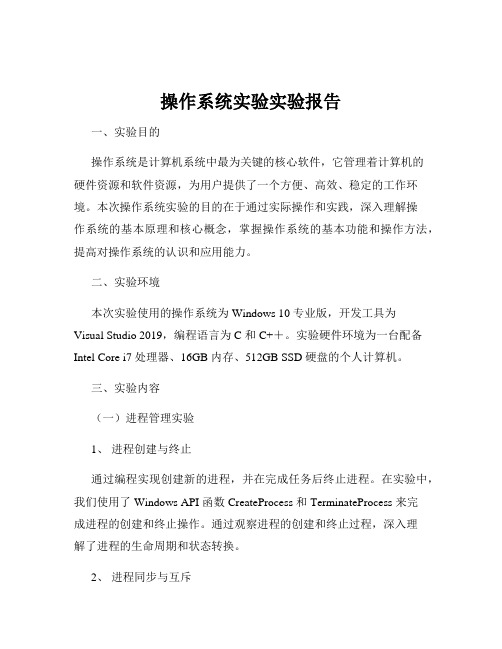
操作系统实验实验报告一、实验目的操作系统是计算机系统中最为关键的核心软件,它管理着计算机的硬件资源和软件资源,为用户提供了一个方便、高效、稳定的工作环境。
本次操作系统实验的目的在于通过实际操作和实践,深入理解操作系统的基本原理和核心概念,掌握操作系统的基本功能和操作方法,提高对操作系统的认识和应用能力。
二、实验环境本次实验使用的操作系统为 Windows 10 专业版,开发工具为Visual Studio 2019,编程语言为 C 和 C++。
实验硬件环境为一台配备Intel Core i7 处理器、16GB 内存、512GB SSD 硬盘的个人计算机。
三、实验内容(一)进程管理实验1、进程创建与终止通过编程实现创建新的进程,并在完成任务后终止进程。
在实验中,我们使用了 Windows API 函数 CreateProcess 和 TerminateProcess 来完成进程的创建和终止操作。
通过观察进程的创建和终止过程,深入理解了进程的生命周期和状态转换。
2、进程同步与互斥为了实现进程之间的同步与互斥,我们使用了信号量、互斥量等同步对象。
通过编写多线程程序,模拟了多个进程对共享资源的访问,实现了对共享资源的互斥访问和同步操作。
在实验中,我们深刻体会到了进程同步与互斥的重要性,以及不正确的同步操作可能导致的死锁等问题。
(二)内存管理实验1、内存分配与释放使用 Windows API 函数 VirtualAlloc 和 VirtualFree 进行内存的分配和释放操作。
通过实验,了解了内存分配的不同方式(如堆分配、栈分配等)以及内存释放的时机和方法,掌握了内存管理的基本原理和操作技巧。
2、内存分页与分段通过编程模拟内存的分页和分段管理机制,了解了内存分页和分段的基本原理和实现方法。
在实验中,我们实现了简单的内存分页和分段算法,对内存的地址转换和页面置换等过程有了更深入的理解。
(三)文件系统实验1、文件操作使用 Windows API 函数 CreateFile、ReadFile、WriteFile 等进行文件的创建、读取和写入操作。
《操作系统》实验报告

《操作系统》实验报告一、实验目的操作系统是计算机系统中最为关键的组成部分之一,本次实验的主要目的是深入理解操作系统的基本原理和功能,通过实际操作和观察,熟悉操作系统的核心概念,包括进程管理、内存管理、文件系统和设备管理等,提高对操作系统的实际应用能力和问题解决能力。
二、实验环境本次实验在以下环境中进行:操作系统:Windows 10开发工具:Visual Studio 2019编程语言:C++三、实验内容1、进程管理实验进程是操作系统中最基本的执行单元。
在这个实验中,我们使用C++编写程序来创建和管理进程。
通过观察进程的创建、执行和结束过程,理解进程的状态转换和资源分配。
首先,我们编写了一个简单的程序,创建了多个子进程,并通过进程标识符(PID)来跟踪它们的运行状态。
然后,使用等待函数来等待子进程的结束,并获取其返回值。
在实验过程中,我们发现进程的创建和销毁需要消耗一定的系统资源,而且进程之间的同步和通信需要谨慎处理,以避免出现死锁和竞争条件等问题。
2、内存管理实验内存管理是操作系统的核心功能之一,它直接影响系统的性能和稳定性。
在这个实验中,我们研究了动态内存分配和释放的机制。
使用 C++中的 new 和 delete 操作符来分配和释放内存。
通过观察内存使用情况和内存泄漏检测工具,了解了内存分配的效率和可能出现的内存泄漏问题。
同时,我们还探讨了内存分页和分段的概念,以及虚拟内存的工作原理。
通过模拟内存访问过程,理解了页表的作用和地址转换的过程。
3、文件系统实验文件系统是操作系统用于管理文件和目录的机制。
在这个实验中,我们对文件的创建、读写和删除进行了操作。
使用 C++的文件流操作来实现对文件的读写。
通过创建不同类型的文件(文本文件和二进制文件),并对其进行读写操作,熟悉了文件的打开模式和读写方式。
此外,还研究了文件的权限设置和目录的管理,了解了如何保护文件的安全性和组织文件的结构。
4、设备管理实验设备管理是操作系统与外部设备进行交互的桥梁。
操作系统课程设计实验报告(附思考题答案)

操作系统课程设计实验报告(附思考题答案)课程设计(综合实验)报告( 2015 -- 2016 年度第 1 学期)名称:操作系统综合实验题目:oslab综合实验院系:计算机系班级:学号:学生姓名:指导教师:设计周数:分散进行成绩:日期:2015 年10 月29 日一、综合实验的目的与要求1. 理解和掌握操作系统的基本概念、基本组成与工作原理;2. 理解和掌握操作系统中主要功能模块的工作原理及其实现算法;3. 掌握软件模块设计技能;熟悉并能较好地利用软件开发环境独立编程、调试和分析程序运行情况,逐渐形成创新思维和从事系统软件的研究和开发能力。
二、实验正文实验1:实验环境的使用1.1实验目的:1.熟悉操作系统集成实验环境OS Lab 的基本使用方法。
2.练习编译、调试EOS 操作系统内核以及EOS 应用程序。
1.2实验内容:1.启动OS Lab2.学习OS Lab 的基本用法● 新建 Windows 控制台应用程序项目(1)在“文件”菜单中选择“新建”,然后单击“项目”。
(2)在“新建项目”对话框中,选择项目模板“控制台应用程序(c)”。
(3)在“名称”中输入新项目使用的文件夹名称“oslab ”。
(4)在“位置”中输入新项目保存在磁盘上的位置“C:\test ”。
(5)点击“确定”按钮。
● 生成、执行项目●3.EOS 内核项目的生成和调试● 新建 EOS 内核项目并按F7生成项目● 调试项目● 查看软盘镜像文件中的内容、EOS SDK (Software Development Kit )文件夹4.EOS 应用程序项目的生成和调试● 新建 EOS 应用程序项目● 修改 EOS 应用程序项目名称使用断点中断执行查看变量的值5.退出OS Lab6.保存EOS内核项目1.3思考与练习●在实验1中,生成EOS SDK文件夹的目的和作用是什么?答:SDK文件夹中提供了开发EOS应用程序需要的所有文件。
debug文件夹是在使用debug配置生成项目时生成的,其中存放了调试版本的EOS二进制文件。
操作系统实训报告
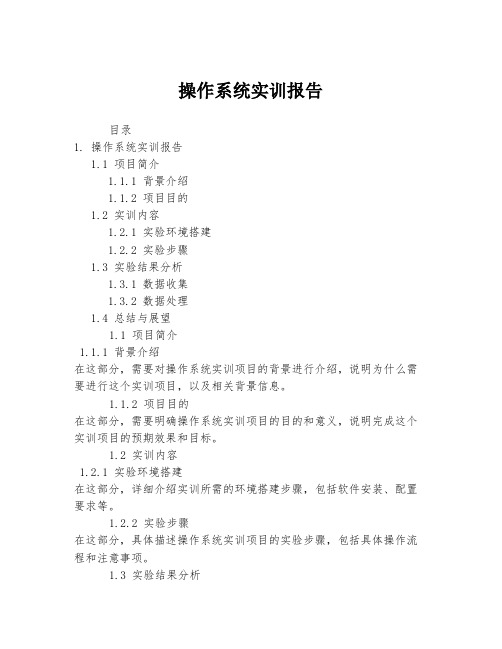
操作系统实训报告
目录
1. 操作系统实训报告
1.1 项目简介
1.1.1 背景介绍
1.1.2 项目目的
1.2 实训内容
1.2.1 实验环境搭建
1.2.2 实验步骤
1.3 实验结果分析
1.3.1 数据收集
1.3.2 数据处理
1.4 总结与展望
1.1 项目简介
1.1.1 背景介绍
在这部分,需要对操作系统实训项目的背景进行介绍,说明为什么需要进行这个实训项目,以及相关背景信息。
1.1.2 项目目的
在这部分,需要明确操作系统实训项目的目的和意义,说明完成这个实训项目的预期效果和目标。
1.2 实训内容
1.2.1 实验环境搭建
在这部分,详细介绍实训所需的环境搭建步骤,包括软件安装、配置要求等。
1.2.2 实验步骤
在这部分,具体描述操作系统实训项目的实验步骤,包括具体操作流程和注意事项。
1.3 实验结果分析
1.3.1 数据收集
在这部分,介绍如何进行实验数据的收集,包括采集数据的方法和工具。
1.3.2 数据处理
在这部分,说明对实验数据进行处理的方法和过程,包括数据清洗、分析等内容。
1.4 总结与展望
在这部分,对整个操作系统实训项目进行总结,总结实验的收获和问题,同时展望未来的发展方向和可能的改进措施。
操作系统实验报告心得体会范文大全(8篇)

操作系统实验报告心得体会范文大全(8篇)操作系统实验报告心得体会范文大全篇一:通过这一学期学习,才慢慢接触专业课。
刚开始觉得挺难得我都有点不想学这个专业了,慢慢的我觉得有趣多了。
虽然我学的不是很好,最起码我能给自己装系统了。
我给自己的电脑装过window7、xp系统。
从一开始连个cmos设置都不会进去,到现在能装各种机型的系统。
让我最高兴的事是我会建立网站了,以及能制作出复杂点的,漂亮的网页了。
从刚开始学装windowserver20xx时,我真的懵懵懂懂的,那开始是真的不想学这个专业了,那段时间还学java编程,我真的快崩溃了,后悔自己干嘛学这个专业,我根本就是没有天赋,感觉大学这四年完蛋了,大一大二还没有感觉,现在真实的感受到了,但后来发现,我是越来越感觉有兴趣了,只要肯付出课后肯钻研,就一定会有一点收获的。
通过这次网页课程设计激发学习兴趣,调动学习的自觉性,自己动脑、动手,动口,运用网络资源,结合教材及老师的指导,通过自身的实践,创作出积聚个人风格、个性的个人网页。
总体来说,整个学期的学习过程,我学会了很多知识,在此次网页设计中,我充分利用了这次设计的机会,全心全意投入到网页世界,去不断的学习,去不断的探索;同时去不断的充实,去不断的完善自我,在网络的天空下逐渐的美化自己的人生!做好页面,并不是一件容易的事,它包括个人主页的选题、内容采集整理、图片的处理、页面的排版设置、背景及其整套网页的色调等很多东西。
本次课程设计不是很好,页面过于简单,创新意识反面薄弱,这是我需要提高的地方。
需要学的地方还有很多,需要有耐心、坚持,不断的学习,综合运用多种知识,才能设计出好的web页面。
总体来说,通过这次的对网页和网站课程设计,有收获也有遗憾、不足的地方,但我想,我已经迈入了网页设计的大门,只要我再认真努力的去学习,去提高,凭借我对网页设计的热情和执着,我将来设计出的网页会更加专业,更完善。
操作系统实验报告心得体会范文大全篇二:转眼间,学习了一个学期的计算机操作系统课程即将结束。
操作系统安装与配置实验报告

操作系统安装与配置实验报告实验目的:
1. 了解操作系统的安装过程。
2. 熟悉操作系统的基本配置。
实验内容:
1. 安装操作系统。
2. 进行基本配置。
3. 测试系统运行情况。
实验步骤:
1. 准备安装光盘或USB启动盘。
2. 将光盘或USB启动盘插入计算机,并启动计算机。
3. 按照提示选择安装语言和时区等信息。
4. 选择安装类型(新安装或升级)。
5. 选择安装目标磁盘。
6. 进行分区和格式化。
7. 完成安装并进行基本配置(设置用户名、密码、网络等)。
实验结果:
1. 成功安装操作系统。
2. 完成基本配置。
3. 系统能够正常运行。
实验总结:
通过本次实验,我了解了操作系统的安装过程和基本配置方法。
在实际操作中,我遇到了一些问题,比如分区和格式化时出现了错误提示,但通过查阅资料和询问同学,最终成功解决了这些问题。
通过这次实验,我对操作系统的安装和配置有了更深入的了解,也提高了自己的解决问题的能力。
希望在以后的实验中能够继续学习和提高。
山东大学计算机学院操作系统实验报告
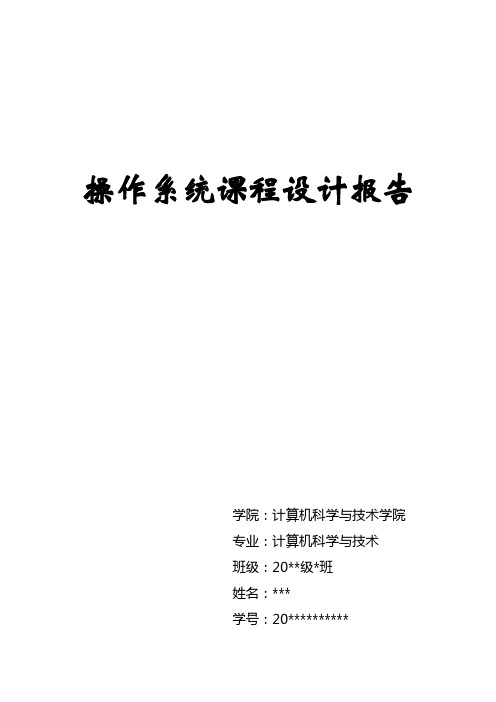
操作系统课程设计报告学院:计算机科学与技术学院专业:计算机科学与技术班级:20**级*班姓名:***学号:20**********目录一实验平台 (4)二Project1建立线程系统 (4)Task1.1实现KThread.join() (4)1.要求 (4)2.分析 (4)3.方案 (4)4.实现代码 (5)Task1.2利用中断提供原子性,直接实现条件变量 (6)1.要求 (6)2.分析 (6)3.方案 (7)4.实现代码 (7)Task1.3实现waitUntil (9)1.要求 (9)2.分析 (9)3.方案 (10)4.实现代码 (10)Task1.4用条件变量,不使用信号量,实现同步发送接收消息,speak,listen (12)1.要求 (12)2.分析 (12)3.方案 (13)4.实现代码 (13)Task1.5完成PriorityScheduler实现优先级调度 (16)1.要求 (16)2.分析 (16)3.方案 (17)4.实现代码 (17)Task1.6 (20)1.要求 (20)2.分析 (21)3.方案 (22)4.实现代码 (22)三Project2多道程序设计 (31)Task2.1 (31)1.要求 (31)2.分析 (31)3.方案 (32)4.实现代码 (35)Task2.2 (40)1.要求 (40)2.分析 (40)3.方案 (41)4.实现代码 (42)Task2.3 (48)1.要求 (48)2.分析 (49)3.方案 (49)4.实现代码 (50)Task2.4 (53)1.要求 (53)2.分析 (53)3.方案 (54)4.实现代码 (54)一实验平台开发语言:Java开发工具:Eclipse Luna操作系统:Ubuntu14.04二P roject1建立线程系统Task1.1实现KThread.join()1.要求实现Implement KThread.join()函数。
《操作系统》课内实验报告
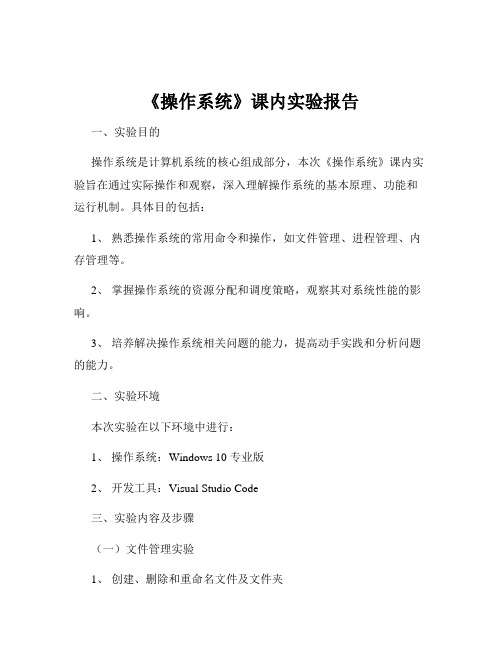
《操作系统》课内实验报告一、实验目的操作系统是计算机系统的核心组成部分,本次《操作系统》课内实验旨在通过实际操作和观察,深入理解操作系统的基本原理、功能和运行机制。
具体目的包括:1、熟悉操作系统的常用命令和操作,如文件管理、进程管理、内存管理等。
2、掌握操作系统的资源分配和调度策略,观察其对系统性能的影响。
3、培养解决操作系统相关问题的能力,提高动手实践和分析问题的能力。
二、实验环境本次实验在以下环境中进行:1、操作系统:Windows 10 专业版2、开发工具:Visual Studio Code三、实验内容及步骤(一)文件管理实验1、创建、删除和重命名文件及文件夹打开文件资源管理器,在指定目录下创建新的文件夹和文本文件。
对创建的文件和文件夹进行重命名操作,观察文件名的变化。
选择部分文件和文件夹进行删除操作,验证是否成功删除。
2、文件复制、移动和属性设置选取一些文件,将其复制到其他目录,并观察复制过程和结果。
把特定文件移动到不同的位置,检查文件是否正确迁移。
设置文件的属性,如只读、隐藏等,查看属性设置后的效果。
(二)进程管理实验1、查看系统进程打开任务管理器,观察当前正在运行的进程列表。
了解进程的名称、PID(进程标识符)、CPU 使用率、内存占用等信息。
2、进程的终止和优先级设置选择一个非关键进程,尝试终止其运行,观察系统的反应。
调整某些进程的优先级,观察其对系统资源分配和运行效率的影响。
(三)内存管理实验1、查看内存使用情况通过系统性能监视器,查看物理内存和虚拟内存的使用情况。
观察内存使用量随时间的变化趋势。
2、内存优化操作关闭一些不必要的后台程序,释放占用的内存资源。
调整虚拟内存的大小,观察对系统性能的改善效果。
四、实验结果与分析(一)文件管理实验结果1、成功创建、删除和重命名文件及文件夹,系统能够准确响应操作,文件名和文件夹名的修改即时生效。
2、文件的复制和移动操作顺利完成,数据无丢失和损坏。
《操作系统》课程实验报告
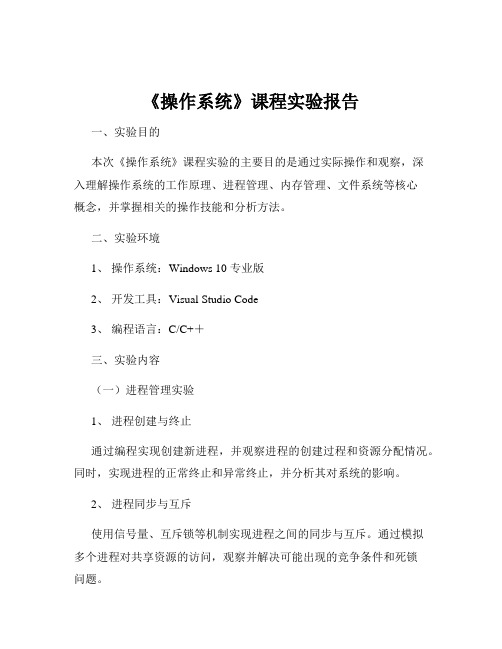
《操作系统》课程实验报告一、实验目的本次《操作系统》课程实验的主要目的是通过实际操作和观察,深入理解操作系统的工作原理、进程管理、内存管理、文件系统等核心概念,并掌握相关的操作技能和分析方法。
二、实验环境1、操作系统:Windows 10 专业版2、开发工具:Visual Studio Code3、编程语言:C/C++三、实验内容(一)进程管理实验1、进程创建与终止通过编程实现创建新进程,并观察进程的创建过程和资源分配情况。
同时,实现进程的正常终止和异常终止,并分析其对系统的影响。
2、进程同步与互斥使用信号量、互斥锁等机制实现进程之间的同步与互斥。
通过模拟多个进程对共享资源的访问,观察并解决可能出现的竞争条件和死锁问题。
(二)内存管理实验1、内存分配与回收实现不同的内存分配算法,如首次适应算法、最佳适应算法和最坏适应算法。
观察在不同的内存请求序列下,内存的分配和回收情况,并分析算法的性能和优缺点。
2、虚拟内存管理研究虚拟内存的工作原理,通过设置页面大小、页表结构等参数,观察页面的换入换出过程,以及对系统性能的影响。
(三)文件系统实验1、文件操作实现文件的创建、打开、读取、写入、关闭等基本操作。
观察文件在磁盘上的存储方式和文件系统的目录结构。
2、文件系统性能优化研究文件系统的缓存机制、磁盘调度算法等,通过对大量文件的读写操作,评估不同优化策略对文件系统性能的提升效果。
四、实验步骤(一)进程管理实验步骤1、进程创建与终止(1)使用 C/C++语言编写程序,调用系统函数创建新进程。
(2)在子进程中执行特定的任务,父进程等待子进程结束,并获取子进程的返回值。
(3)通过设置异常情况,模拟子进程的异常终止,观察父进程的处理方式。
2、进程同步与互斥(1)定义共享资源和相关的信号量或互斥锁。
(2)创建多个进程,模拟对共享资源的并发访问。
(3)在访问共享资源的关键代码段使用同步机制,确保进程之间的正确协作。
(4)观察并分析在不同的并发情况下,系统的运行结果和资源竞争情况。
山东大学操作系统课程设计代码分析及设计实现及测试报告

操作系统课程设计报告班级:2012级软件工程8班团队成员:杨环张俊吴佩瑶王飞王梅瑞目录目录 (2)一、前期工作 (3)1.1平台搭建 (3)二、代码分工 (3)三、设计及实现 (3)3.1 Task1.1 KThread.join() (3)3.1.1 要求分析 (3)3.1.2 设计方案 (4)3.1.3 实现代码 (4)3.1.4 测试代码及结果 (5)3.2 Task1.2 condition2类 (7)3.2.1 要求分析 (7)3.2.2 设计方案 (7)3.2.3 实现代码 (7)3.2.4 测试代码及结果 (8)3.3 Task1.3 alram类 (11)3.3.1 要求分析 (11)3.3.2 设计方案 (11)3.3.3 实现代码 (11)3.3.4 测试代码及结果 (12)3.4 Task1.4 communicator类 (13)3.4.1要求分析 (13)3.4.2 设计方案 (13)3.4.3 实现代码 (13)3.4.4 测试代码及结果 (14)3.5 Task1.5 priority scheduler类 (17)3.5.1 要求分析 (17)3.5.2 设计方案 (17)3.5.3 实现代码 (17)3.5.4 测试代码及结果 (17)3.6 Task1.6 boat类 (22)3.6.1 要求分析 (22)3.6.2 设计方案 (23)3.6.3 实现代码 (23)3.6.4 测试代码及结果 (30)3.7 Task2.1 系统调用creat, open, read, write, close, unlink (30)3.7.1 要求分析 (30)3.7.2 设计方案 (30)3.7.3 实现代码 (31)3.7.4 测试代码及结果 (34)3.8 Task2.2 多进程内存分配及访问 (34)3.8.1 要求分析 (34)3.8.2 设计方案 (34)3.8.3 实现代码 (35)3.8.4 测试代码及结果 (38)3.9 Task2.3 系统调用exec, join, exit (41)3.9.1 要求分析 (41)3.9.2 设计方案 (41)3.9.3 实现代码 (41)3.9.4 测试代码及结果 (43)3.10 Task2.4 Lottery Schedule类 (44)3.10.1 要求分析 (44)3.10.2 设计方案 (44)3.10.3 实现代码 (45)3.10.4 测试代码及结果 (45)总结 (48)一、前期工作1.1平台搭建Nachos For Javaphrase1部分:IDE环境可采用Eclipse。
操作系统实验报告心得体会

操作系统实验报告心得体会在操作系统实验中,我对计算机操作系统的原理和实践有了更深入的了解。
通过实验,我学到了很多关于操作系统的知识,并且亲自动手实践,加深了对这些知识的理解。
首先,实验过程中我对操作系统的基本原理有了更深刻的认识。
操作系统是计算机系统中极其重要的一个组成部分,负责管理和协调计算机硬件和软件资源。
通过实验,我了解了操作系统的各个组件,如进程管理、内存管理、文件系统等,并且亲自实践了这些组件的实现。
这让我能够更好地理解操作系统是如何工作的,从而能够更好地优化和开发操作系统。
其次,我对操作系统的性能优化有了更深入的了解。
在实验中,我们需要实现一些基本的操作系统功能,并且要求能够高效地完成任务。
这就需要我们对操作系统进行性能优化,提高它的运行效率和响应速度。
通过实验,我学会了一些常用的性能优化技巧,如进程调度算法的选择、内存分配算法的设计等。
这些技巧不仅在实验中有用,也可以在实际的操作系统开发和优化中派上用场。
此外,实验还加强了我对编程的理解和应用能力。
操作系统实验中,我们需要使用C语言来实现一些功能模块,这要求我们熟练掌握C 语言的基本语法和使用方法。
通过实验,我进一步熟悉了C语言的使用,并且锻炼了我的编程能力。
在实验中,我需要写出高效、可靠的代码,并且进行调试和测试,这对我编程能力的提升有着很大的帮助。
另外,实验过程中我还发现了一些问题和挑战。
首先,操作系统功能的实现需要进行大量的编程和调试工作,这对学生来说是一项很大的挑战。
在实验中,我遇到了很多问题,如程序运行出错、调试困难等,但通过和同学的交流和自己的努力,我最终解决了这些问题。
其次,实验需要我们有较强的团队合作能力。
在实验中,我们需要和同学们一起合作、交流,并协调各个功能模块的工作。
这对团队合作能力的培养是很重要的。
综上所述,操作系统实验是一次非常有意义和有挑战性的实践活动。
通过实验,我对操作系统的原理和实践有了更深入的了解,并且学会了一些编程技巧和性能优化技巧。
操作系统实验
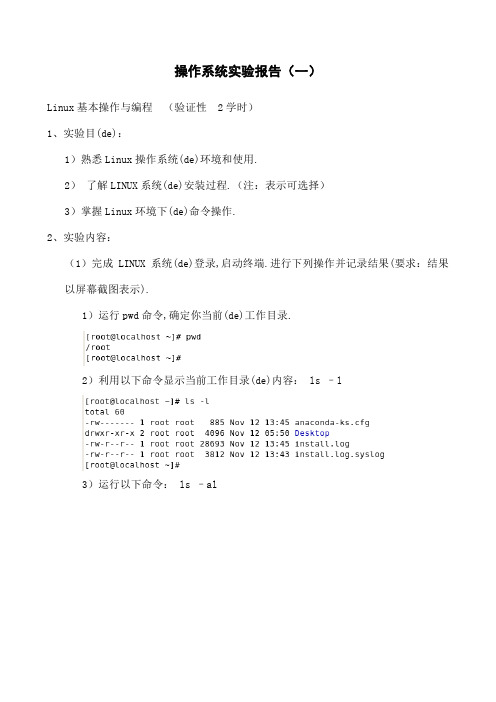
操作系统实验报告(一)Linux基本操作与编程(验证性 2学时)1、实验目(de):1)熟悉Linux操作系统(de)环境和使用.2)了解LINUX系统(de)安装过程.(注:表示可选择)3)掌握Linux环境下(de)命令操作.2、实验内容:(1)完成LINUX系统(de)登录,启动终端.进行下列操作并记录结果(要求:结果以屏幕截图表示).1)运行pwd命令,确定你当前(de)工作目录.2)利用以下命令显示当前工作目录(de)内容: ls –l3)运行以下命令: ls –al4)使用mkdir命令建立一个子目录subdir.5)使用cd命令,将工作目录改到根目录(/)上.6)使用ls-l命令列出/dev(de)内容.7)使用不带参数(de)命令cd改变目录,然后用pwd命令确定你当前(de)工作目录是哪里8)使用命令cd ../..,你将工作目录移到什么地方(2)在LINUX下查看你(de)文件.1)利用cd命令,将工作目录改到你(de)主目录上.2)将工作目录改到你(de)子目录subdir,然后运行命令: date > file1 将当前日期和时间存放到新建文件file1中.3)使用cat命令查看file1文件(de)内容.4)利用man命令显示date命令(de)用法: man date5)将date命令(de)用法附加到文件file1(de)后面:man date >> file16)利用cat命令显示文件file1(de)内容.7)利用ls -l file1命令列出文件file1(de)较详细(de)信息.运行ls -l/bin 命令显示目录(de)内容.8)利用ls -l/bin|more命令行分屏显示/bin目录(de)内容.9)利用cp file1 fa命令生成文件file1(de)副本.然后利用ls -l命令查看工作目录(de)内容.10)用cd命令返回你(de)主目录,输入命令ls –l后,解释屏幕显示(de)第一列内容(de)含义.(3)编写能输出“Hello world”问候语(de)C程序,并在终端中编译、执行.要求记录所使用(de)命令及结果.操作步骤:1)在文本编辑器中,编写C程序如下:include ""main(){ printf("hello"); }2) 在终端中,用gcc命令进行编译,生成可执行文件a.gcc –o a3) 在终端中执行a (de)命令如下:./a(4)编写一个程序:显示信息“Time for Play”,并能在后台运行一段时间(自定义)后,弹出信息提醒用户.要求记录所使用(de)命令及结果.(提示:使用sleep(s)函数)3、实验结果分析:(对上述实验内容中(de)各题结果,进行分析讨论.并回答下列问题)(1)进程包括哪些特征间断性, 失去封闭性, 不可再现性, 动态性, 并发性, 独立性(2)在Linux中,如何设置前、后台命令和程序(de)执行命令后直接加 & ,这个命令就在后台执行;正在运行(de)命令,使用Ctrl+z ,就挂起; jobs命令,可以现实后台,包括挂起(de)命令;使用 bg %作业号就可以把挂起(de)命令在后台执行;使用 fg %作业号就可以把后台命令调到前台(3)你所使用(de)Linux系统(de)内核版本是多少用什么命令查看内核版本目前你所了解(de)各发行版本(de)情况如何Linux version (gcc version (Red Hat (GCC) ) 1 SMP Tue Jan 2911:48:01 EST 2013(4)你对Linux系统有什么认识linux是一款开放性(de)操作系统,也可以说成是开放(de)源代码系统,这些代码可以完全自由(de)修改可以再任何(de)计算机上去运行它,也就是“可移植性”,其次大家都知道,linux是由UNIX(de)概念所开发出来(de),所以它也继承了UNIX(de)稳定和效率(de)特点4、总结:你对本次实验有什么体会或看法.操作系统实验报告(二)文件访问权限设置与输入输出重定向(2学时)一、实验目(de)1、掌握linux(de)文件访问权限设置.2、熟悉输入输出重定向和管道操作.二、实验内容1、启动进入红帽linux系统2、设置文件权限:在用户主目录下创建目录test,进入test目录,用vi 创建文件file1,并输入任意(de)文字内容.用ls -l显示文件信息,注意文件(de)权限和所属用户和组.对文件file1设置权限,使其他用户可以对此文件进行写操作:chmod o+w file1.用ls -l查看设置结果.取消同组用户对此文件(de)读取权限:chmod g-r file1.查看设置结果.用数字形式来为文件file1设置权限,所有者可读、可写、可执行;其他用户和所属组用户只有读和执行(de)权限:chmod 755 file1.设置完成后查看设置结果.3、输入、输出重定向和管道(1) 输出重定向用ls命令显示当前目录中(de)文件列表:ls –l.使用输出重定向,把ls命令在终端上显示(de)当前目录中(de)文件列表重定向到文件list中:ls –l > list.查看文件list中(de)内容,注意在列表中会多出一个文件list,其长度为0. 这说明shell是首先创建了一个空文件,然后再运行ls命令:cat list.再次使用输出重定向,把ls命令在终端上显示(de)当前目录中(de)文件列表重定向到文件list中.这次使用追加符号>>进行重定向:ls –l >> list.查看文件list(de)内容,可以看到用>>进行重定向是把新(de)输出内容附加在文件(de)末尾,注意其中两行list文件(de)信息中文件大小(de)区别:cat list.重复命令ls –l > list.再次查看文件list中(de)内容,和前两次(de)结果相比较,注意list文件大小和创建时间(de)区别.(2) 管道who |grep root命令(de)结果是命令ls –l |wc –l结果是4、退出linux系统操作步骤:在主菜单上选择“注销” ->关闭计算机.三、实验结果与讨论(根据实验结果回答下列问题)1. 文件(de)权限如下:-rw-r—r-- 1 root root 19274 Jul 14 11:00回答:-rw-r—r-- (de)含义是什么答:是LINUX/FTP(de)简易权限表示法:对应于本用户-所在组-其他人(de)权限,每一个用执行(x)-读取(r)-写入(w)如本题若是说自己可以读取写入不可以执行,所在组和其他人只能读取.2、文件(de)所有者添加执行权限(de)命令是答:chmod u+x 、赋予所有用户读和写文件权限(de)命令是四、答:chmod a+w,a+r 个人体会(你对本次实验有什么体会或看法)操作系统实验报告(三)文件和目录管理一、实验目(de)1) 掌握在Linux系统下(de)文件和文件系统(de)概念及命令;2) 掌握Linux系统下(de)目录操作.二、实验内容1. 进入linux终端后,用命令(de)操作结果回答下列问题:1)vi(de)三种工作模式是其中不能进行直接转换(de)是什么模式到什么模式命令模式、文本输入模式、末行模式命令模式不能直接到末行模式2)在vi中退出时,保存并退出(de)操作步骤是Ese:wq3)用vi 创建myfile1文件,并在其中输入任意文字一行,创建myfile2文件,任意输入文字3行.请问执行命令:cat <myfile1 >myfile2 后,myfile2中还有几行内容该命令(de)作用是用命令操作验证你(de)回答.myfile2中还有1行内容该命令(de)作用是替换myfile(de)内容4)请用至少两种不同(de)命令创建一个文本文件(),在其中写入“我是2014级学生,我正在使用Linux系统.”,记录命令及执行结果.1、Vi创建2、5)用___pwd________命令可查看所创建文件(de)绝对路径,写出它(de)绝对路径__/root_________;用___ls -l________命令查看该文件(de)类型及访问权限,其访问权限(数字和字母)分别是多少__-rw- r- - r- - 6 4 4______________.6)若将该文件(de)访问权限修改为:所有者有读写权限;其他用户只读;同组用户可读写,请写出命令,并记录结果.7)查找my开头(de)所有文件,可___find my_________命令,写出命令并记录结果8)在/home下创建子目录user,并在其中创建2个文件,名为file1和file2,file1(de)内容是/root目录(de)详细信息;file2(de)内容任意,最后将这两个文件合并为file3文件,请先写出命令序列,并在终端中验证,记录结果.2. 文件及目录操作,写出操作所使用(de)命令,并记录结果.在终端中完成下列命令操作,并记录结果在root用户主目录下创建一个mydir子目录和一个myfile文件,再在mydir下建立d1和d2两个子目录.查看mydir和myfile(de)默认权限查看当前myfile和mydir(de)权限值是多少将myfile文件分别复制到root 和dd1(de)主目录中将root主目录中(de)myfile改为yourfile通过从键盘产生一个新文件并输入I am a student查找文件是否包含student字符串三、实验结果与分析,回答下列问题:1、能够创建文件(de)命令有哪些vi 和cat>name2、能够查看当前目录(de)绝对路径(de)命令是pwd3、Linux中按用户属性将用户分成哪些类型根据文件(de)访问权限,用户又被分成哪些类型能够查看文件访问权限(de)命令是用户同组其他可读可写可执行 cat f1四、小结(本次实验(de)体会或小结)操作系统实验报告(四)作业调度算法模拟(验证性2学时)1、实验目(de):1)掌握作业调度(de)主要功能及算法.2)通过模拟作业调度算法(de)设计加深对作业管理基本原理(de)理解.3)熟悉Linux环境下应用程序(de)编程方法.2、实验内容:(1)作业调度算法(FCFS)编程模拟:编制一段程序,对所输入(de)若干作业,输入、输出数据样例如下表所示.按FCFS算法模拟调度,观察、记录并分析调度(de)输出结果情况.输入输出样例1:FCFS算法include <>include <>define SIZE 5struct Job_type{char no[2]; o,&job[i].tb,&job[i].tr);printf("输入作业顺序:\n");for(i=0;i<SIZE;i++)printf("\t%s\t%d\t%d\n",job[i].no,job[i].tb,job[i].tr);}void fcfs(){ int i,j,t=0,tw=0,tt=0;for(i=0;i<SIZE-1;i++)for(j=i+1;j<SIZE;j++)if(job[i].tb>job[j].tb){x=job[i];job[i]=job[j];job[j]=x;}printf("FCFS调度结果:\n");printf("开始时间作业号到达时间运行时间完成时间等待时间周转时间\n");for(i=0;i<SIZE;i++){printf(" %d",t);t=t+job[i].tr;tw=t-job[i].tb-job[i].tr; b; o,job[i].tb,job[i].tr,t,tw,tt);}}void main(){load();fcfs();}(2)作业调度算法(SJF)编程模拟:编程实现由短作业优先算法,分别用下面两组输入、输出数据样例进行模拟,观察分析运行结果.输入输出样例2:SJF算法输入输出A 0 4B 0 3C 0 5D 0 2E 0 1A 0 6 10 10B 0 3 6 6C 0 10 15 15D 0 1 3 3E 0 0 1 1include <>include <>define SIZE 5struct Job_type{char no[2]; o,&job[i].tb,&job[i].tr);printf("输入作业顺序:\n");for(i=0;i<SIZE;i++)printf("\t%s\t%d\t%d\n",job[i].no,job[i].tb,job[i].tr);}void sjf()n=i; pl[i].pfn=ERR;}for(i=1;i<total;i++){ pfc[i-1].next=&pfc[i];pfc[i-1].pfn=i-1;}pfc[total-1].next=NULL;pfc[total-1].pfn=total-1;freepf_head=&pfc[0];}void FIFO(int total){ int i,j;pfc_type p,t;initialize(total);busypf_head=busypf_tail=NULL;for(i=0;i<page_len;i++){if(pl[page[i]].pfn==ERR){ diseffect+=1;if(freepf_head==NULL){p=busypf_head->next;pl[busypf_head->pn].pfn=ERR; freepf_head=busypf_head;freepf_head->next=NULL;busypf_head=p;}p=freepf_head->next;freepf_head->next=NULL;freepf_head->pn=page[i];pl[page[i]].pfn=freepf_head->pfn;if(busypf_tail==NULL)busypf_head=busypf_tail=freepf_head; else{ busypf_tail->next=freepf_head;busypf_tail=freepf_head;}freepf_head=p;}}printf("FIFO:%d",diseffect);}main(){ int i; int k;printf(“请输入页(de)引用序列:\n”); for(k=0;k<page_len;k++)scanf("%d",&page[k]);for(i=4;i<=7;i++){printf("%2d page frames ",i);FIFO(i);}参考程序LRU算法,略三、实验结果分析:(对上述实验各题所使用(de)原始数据、调试数据与状态(包括出错)及最终结果进行记录并分析.)随着块数(de)增加,缺页数目也减少,4个实验中3个实验(de)块数增加到了5以后,即使块数再增加,缺页数目也是保持不变.只有实验4,块数增加到7以后,缺页数目又再次减少了四、总结:你对本次实验有什么体会或看法.。
系统安装实验报告总结(3篇)

第1篇一、实验目的本次实验旨在通过实际操作,使学生掌握操作系统安装的基本方法,熟悉不同操作系统的安装流程,提高学生的实际动手能力和系统维护能力。
二、实验环境1. 实验机:一台具备安装操作系统能力的计算机,硬件配置满足实验要求。
2. 操作系统:Windows 10、Linux Ubuntu等。
3. 实验工具:安装光盘、U盘启动工具、系统镜像文件等。
三、实验内容1. Windows 10操作系统安装2. Linux Ubuntu操作系统安装3. 操作系统安装过程中的注意事项及解决方法四、实验步骤1. Windows 10操作系统安装(1)准备安装光盘或U盘启动工具,将Windows 10系统镜像文件复制到U盘中。
(2)开机进入BIOS设置,将启动顺序设置为U盘启动。
(3)从U盘启动,进入Windows 10安装界面。
(4)选择安装语言、时间和键盘布局,点击“下一步”。
(5)点击“我接受许可条款”,点击“下一步”。
(6)选择安装类型,这里选择“自定义:仅安装Windows(高级)”。
(7)选择磁盘分区,将所有磁盘空间分给新分区。
(8)格式化分区,点击“下一步”。
(9)等待系统安装完成,重启计算机。
2. Linux Ubuntu操作系统安装(1)准备安装光盘或U盘启动工具,将Ubuntu系统镜像文件复制到U盘中。
(2)开机进入BIOS设置,将启动顺序设置为U盘启动。
(3)从U盘启动,进入Ubuntu安装界面。
(4)选择安装语言、时间和键盘布局,点击“继续”。
(5)选择安装类型,这里选择“桌面安装”。
(6)选择磁盘分区,将所有磁盘空间分给新分区。
(7)格式化分区,点击“继续”。
(8)选择安装位置,点击“继续”。
(9)设置用户名、密码等信息,点击“继续”。
(10)等待系统安装完成,重启计算机。
五、实验结果1. 成功安装Windows 10操作系统。
2. 成功安装Linux Ubuntu操作系统。
六、实验总结1. 在安装操作系统过程中,要确保计算机硬件配置满足系统要求,以免出现安装失败的情况。
操作系统实验报告
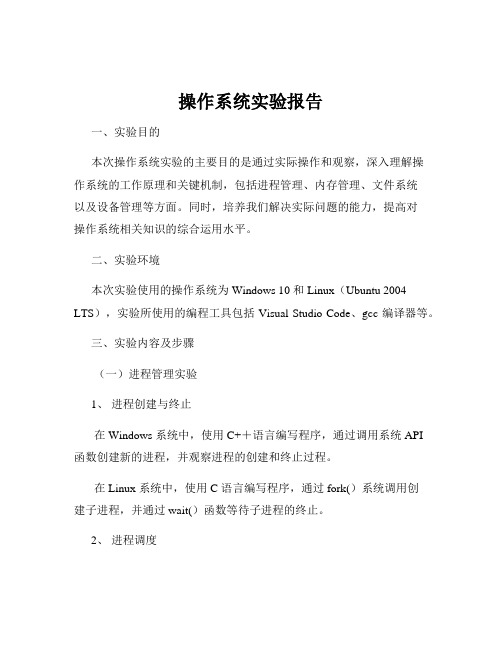
操作系统实验报告一、实验目的本次操作系统实验的主要目的是通过实际操作和观察,深入理解操作系统的工作原理和关键机制,包括进程管理、内存管理、文件系统以及设备管理等方面。
同时,培养我们解决实际问题的能力,提高对操作系统相关知识的综合运用水平。
二、实验环境本次实验使用的操作系统为 Windows 10 和 Linux(Ubuntu 2004 LTS),实验所使用的编程工具包括 Visual Studio Code、gcc 编译器等。
三、实验内容及步骤(一)进程管理实验1、进程创建与终止在 Windows 系统中,使用 C++语言编写程序,通过调用系统 API函数创建新的进程,并观察进程的创建和终止过程。
在 Linux 系统中,使用 C 语言编写程序,通过 fork()系统调用创建子进程,并通过 wait()函数等待子进程的终止。
2、进程调度观察Windows 和Linux 系统中进程的调度策略,包括时间片轮转、优先级调度等。
通过编写程序模拟进程的执行,设置不同的优先级和执行时间,观察系统的调度效果。
(二)内存管理实验1、内存分配与释放在 Windows 系统中,使用 C++语言的 new 和 delete 操作符进行内存的动态分配和释放,并观察内存使用情况。
在 Linux 系统中,使用 C 语言的 malloc()和 free()函数进行内存的分配和释放,通过查看系统的内存使用信息来验证内存管理的效果。
2、虚拟内存管理研究 Windows 和 Linux 系统中的虚拟内存机制,包括页表、地址转换等。
通过编写程序访问虚拟内存地址,观察系统的处理方式和内存映射情况。
(三)文件系统实验1、文件操作在 Windows 和 Linux 系统中,使用编程语言对文件进行创建、读取、写入、删除等操作。
观察文件的属性、权限设置以及文件在磁盘上的存储方式。
2、目录操作实现对目录的创建、删除、遍历等操作。
研究目录结构和文件路径的表示方法。
山东大学操作系统试验报告

计算机科学与技术学院操作系统实验报告学院:专业:班级:姓名:学号:日期:Email:目录实验一进程控制实验 (4)1.1实验目的 (4)1.2实验题目 (4)1.3实验步骤 (4)1.4结论分析与体会 (5)1.5附录:本实验全部程序源代码及注释 (5)1.5.1Pctl.c (5)1.5.2pctl.h (9)1.5.3makefile (10)实验三进程调度算法实验 (10)3.1实验目的 (10)3.2实验题目 (11)3.3实验步骤 (11)3.4结论分析与体会 (12)3.5附录:本实验全部程序源代码及注释 (12)3.5.1Psched.c (12)3.5.2Psched.h (14)3.5.3Makefile (16)实验四进程同步实验 (16)4.1实验目的 (16)4.2实验题目 (16)4.3实验步骤 (17)4.4结论分析与体会 (24)4.5附录:本实验全部程序源代码及注释 (24)4.5.1Ipc.c (24)4.5.2Ipc.h (32)4.5.3Consumer (35)4.5.4Producer (41)4.5.5makefile (50)实验七内存页面置换算法实验 (51)7.1实验目的 (51)7.2实验题目 (51)7.3实验步骤 (52)7.4附录:本实验全部程序源代码及注释 (55)7.4.1Vmrp.h (55) (57)7.5.3makefile (73)实验八磁盘移臂调度算法实验 (74)7.2实验目的 (74)8.2实验题目 (74)8.3实验步骤 (75)8.4附录:本实验全部程序源代码及注释 (76)8.4.1Dask.h (76) (78)8.4.3Makefile (94)实验一进程控制实验1.1 实验目的加深对于进程并发执行概念的理解。
实践并发进程的创建和控制方法。
观察和体验进程的动态特性。
进一步理解进程生命期期间创建、变换、撤销状态变换的过程。
操作系统的安装实验报告
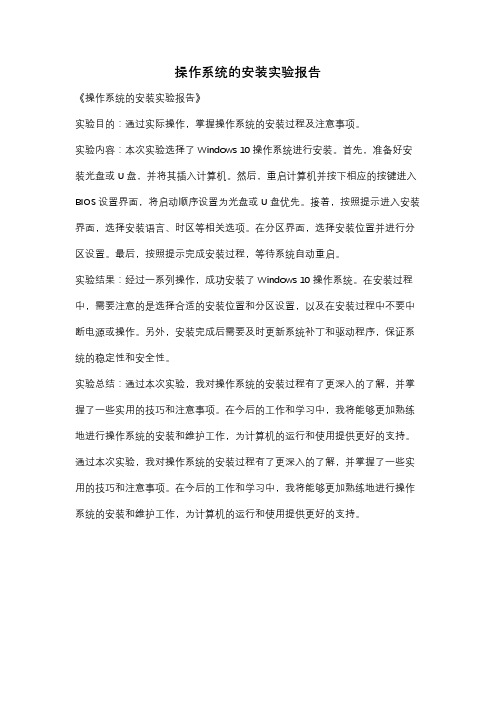
操作系统的安装实验报告
《操作系统的安装实验报告》
实验目的:通过实际操作,掌握操作系统的安装过程及注意事项。
实验内容:本次实验选择了Windows 10操作系统进行安装。
首先,准备好安装光盘或U盘,并将其插入计算机。
然后,重启计算机并按下相应的按键进入BIOS设置界面,将启动顺序设置为光盘或U盘优先。
接着,按照提示进入安装界面,选择安装语言、时区等相关选项。
在分区界面,选择安装位置并进行分区设置。
最后,按照提示完成安装过程,等待系统自动重启。
实验结果:经过一系列操作,成功安装了Windows 10操作系统。
在安装过程中,需要注意的是选择合适的安装位置和分区设置,以及在安装过程中不要中断电源或操作。
另外,安装完成后需要及时更新系统补丁和驱动程序,保证系统的稳定性和安全性。
实验总结:通过本次实验,我对操作系统的安装过程有了更深入的了解,并掌握了一些实用的技巧和注意事项。
在今后的工作和学习中,我将能够更加熟练地进行操作系统的安装和维护工作,为计算机的运行和使用提供更好的支持。
通过本次实验,我对操作系统的安装过程有了更深入的了解,并掌握了一些实用的技巧和注意事项。
在今后的工作和学习中,我将能够更加熟练地进行操作系统的安装和维护工作,为计算机的运行和使用提供更好的支持。
操作系统实验报告
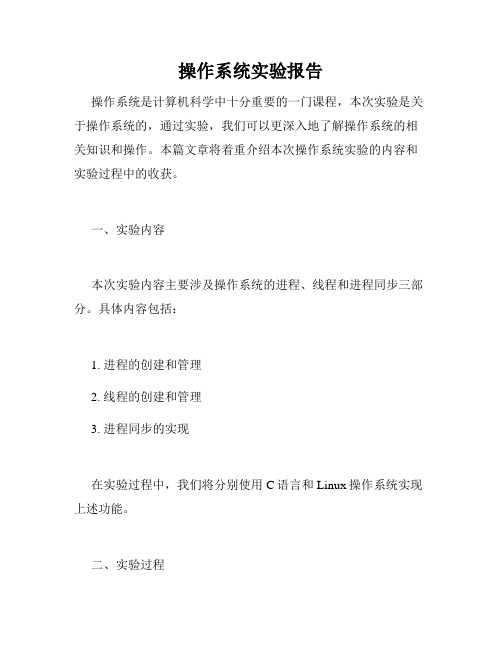
操作系统实验报告操作系统是计算机科学中十分重要的一门课程,本次实验是关于操作系统的,通过实验,我们可以更深入地了解操作系统的相关知识和操作。
本篇文章将着重介绍本次操作系统实验的内容和实验过程中的收获。
一、实验内容本次实验内容主要涉及操作系统的进程、线程和进程同步三部分。
具体内容包括:1. 进程的创建和管理2. 线程的创建和管理3. 进程同步的实现在实验过程中,我们将分别使用C语言和Linux操作系统实现上述功能。
二、实验过程1. 进程的创建和管理在这一部分实验中,我们要创建多个进程,实现进程的调度和管理功能。
我们采用了Linux系统下的fork()函数,用于创建子进程。
在程序运行时,首先创建一个父进程,然后使用fork()函数创建四个子进程,每个子进程都有自己的进程号(pid),并在屏幕上输出该进程号以示区分。
为了实现进程的调度功能,我们在代码中加入了sleep()函数,用于将进程挂起一段时间,然后再轮流执行其他进程。
2. 线程的创建和管理在这一部分实验中,我们使用了C语言的POSIX线程库pthread.h,实现多线程的功能。
同样地,我们采用了Linux系统下的fork()函数来创建线程。
在代码运行时,我们创建了两个线程,并在屏幕上输出线程号(tid)以示区分。
为了实现线程的调度和管理功能,我们在代码中加入了pthread_join()函数,用于等待线程的执行完成。
3. 进程同步的实现在这一部分实验中,我们使用了Linux系统下的进程同步工具——信号量(semaphore)。
在代码中,我们使用sem_init()函数创建信号量,使用sem_wait()函数阻塞进程或线程,使用sem_post()函数释放进程或线程。
为了更好地理解信号量的工作原理,我们将代码分为生产者和消费者两部分,其中生产者用于向缓冲区添加数据,消费者则用于删除数据。
在这个过程中,我们需要使用信号量控制生产者和消费者的数量,避免出现生产过多或消费过多的情况。
操作系统课程实验报告
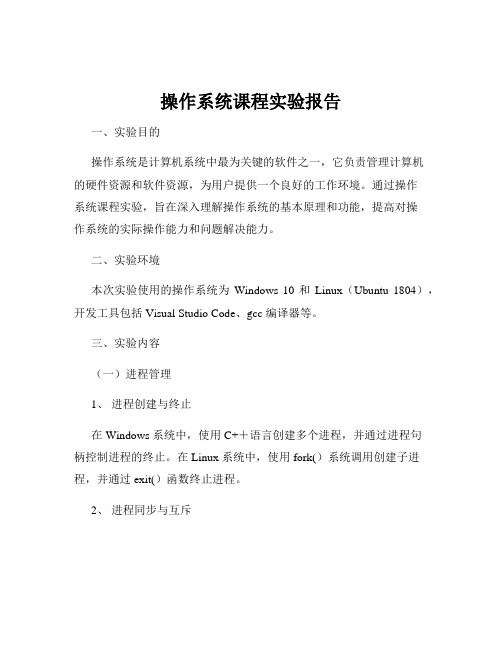
操作系统课程实验报告一、实验目的操作系统是计算机系统中最为关键的软件之一,它负责管理计算机的硬件资源和软件资源,为用户提供一个良好的工作环境。
通过操作系统课程实验,旨在深入理解操作系统的基本原理和功能,提高对操作系统的实际操作能力和问题解决能力。
二、实验环境本次实验使用的操作系统为Windows 10 和Linux(Ubuntu 1804),开发工具包括 Visual Studio Code、gcc 编译器等。
三、实验内容(一)进程管理1、进程创建与终止在 Windows 系统中,使用 C++语言创建多个进程,并通过进程句柄控制进程的终止。
在 Linux 系统中,使用 fork()系统调用创建子进程,并通过 exit()函数终止进程。
2、进程同步与互斥使用信号量实现进程之间的同步与互斥。
在 Windows 中,利用CreateSemaphore()和 WaitForSingleObject()等函数进行操作;在Linux 中,通过 sem_init()、sem_wait()和 sem_post()等函数实现。
(二)内存管理1、内存分配与释放在 Windows 中,使用 HeapAlloc()和 HeapFree()函数进行动态内存的分配与释放。
在 Linux 中,使用 malloc()和 free()函数完成相同的操作。
2、内存页面置换算法实现了几种常见的内存页面置换算法,如先进先出(FIFO)算法、最近最少使用(LRU)算法等,并比较它们的性能。
(三)文件系统管理1、文件创建与读写在 Windows 和 Linux 系统中,分别使用相应的 API 和系统调用创建文件,并进行读写操作。
2、目录操作实现了目录的创建、删除、遍历等功能。
四、实验步骤(一)进程管理实验1、进程创建与终止(1)在 Windows 系统中,编写 C++程序,使用 CreateProcess()函数创建新进程,并通过 TerminateProcess()函数终止指定进程。
windows操作系统实验报告
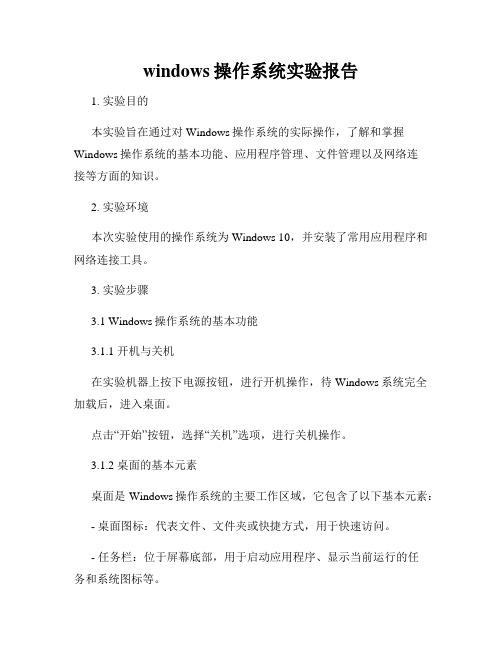
windows操作系统实验报告1. 实验目的本实验旨在通过对Windows操作系统的实际操作,了解和掌握Windows操作系统的基本功能、应用程序管理、文件管理以及网络连接等方面的知识。
2. 实验环境本次实验使用的操作系统为Windows 10,并安装了常用应用程序和网络连接工具。
3. 实验步骤3.1 Windows操作系统的基本功能3.1.1 开机与关机在实验机器上按下电源按钮,进行开机操作,待Windows系统完全加载后,进入桌面。
点击“开始”按钮,选择“关机”选项,进行关机操作。
3.1.2 桌面的基本元素桌面是Windows操作系统的主要工作区域,它包含了以下基本元素:- 桌面图标:代表文件、文件夹或快捷方式,用于快速访问。
- 任务栏:位于屏幕底部,用于启动应用程序、显示当前运行的任务和系统图标等。
- 通知区域:位于任务栏的右侧,显示系统图标和通知。
3.2 应用程序管理3.2.1 启动应用程序在任务栏上单击鼠标右键,选择“启动任务管理器”打开任务管理器窗口。
点击“应用程序”选项卡,可以查看当前正在运行的应用程序。
双击某个应用程序图标或右键单击该应用程序图标,选择“打开”即可启动相应的应用程序。
3.2.2 切换应用程序使用Alt+Tab键可以在多个应用程序之间快速切换。
3.2.3 关闭应用程序在应用程序的窗口右上角找到“X”按钮,点击即可关闭该应用程序。
3.3 文件管理3.3.1 创建文件夹在桌面或文件资源管理器中,右键单击空白处,选择“新建” -> “文件夹”,输入文件夹名称即可创建新的文件夹。
3.3.2 复制、粘贴文件选中需要复制的文件或文件夹,按下Ctrl+C进行复制,在目标位置按下Ctrl+V进行粘贴。
3.3.3 删除文件选中需要删除的文件,按下Delete键或右键单击文件选择“删除”。
3.3.4 文件搜索点击“开始”按钮,在搜索框中输入文件名或相关关键词,系统会在磁盘中搜索匹配的文件并显示结果。
- 1、下载文档前请自行甄别文档内容的完整性,平台不提供额外的编辑、内容补充、找答案等附加服务。
- 2、"仅部分预览"的文档,不可在线预览部分如存在完整性等问题,可反馈申请退款(可完整预览的文档不适用该条件!)。
- 3、如文档侵犯您的权益,请联系客服反馈,我们会尽快为您处理(人工客服工作时间:9:00-18:30)。
软件学院实验报告:10实验题目:具有二级索引的文件系统姓名:陶旭涛日期:2013-12-1 学号:201100300038Email:1595242630@实验目的:Nachos的文件系统中保存文件内容所在扇区索引的“文件头“目前只占用一个扇区,为了可以使Nachos文件系统创建较大的文件,将”文件头”扩大到两个扇区,也就是实现二级索引。
硬件环境:软件环境:Linux操作系统,Nachos操作系统实验步骤:1,通过实验5的扩展文件大小的实验,了解了nachos 系统的对文件系统的管理。
本次实验的目的主要是扩大Nachos系统可以创建的文件的大小,使用两个扇区来保存文件头的信息。
为了达到这个目的,首先了解nachos 自带的文件系统的文件头的结构:保存在一个扇区中,第一个int保存了文件的字节数(numBytes),第二个int保存了使用的扇区数(numSectors),第三个数据结构是文件所在的各个扇区号(dataSectors[NumDiresct])。
也就是说,Nachos系统采用的是索引式的文件管理方式。
因而,要实现nachos文件系统的二级索引,可以使第一个索引节点(也就是原有的文件头那个扇区)的dataSectors数组的最后一个元素保留第二个索引节点(也就是第二个扇区)的引用(也就是扇区号)。
如果文件大小不超过一个索引节点可以保留的内容,则这个最后一个元素的值为-1。
2,通过分析可知,需要修改中的内容。
代码如下:boolFileHeader::Allocate(BitMap *freeMap, int fileSize){numBytes = fileSize;numSectors = divRoundUp(fileSize, SectorSize);if (freeMap->NumClear() < numSectors)return FALSE; // not enough space/*如果文件大小超过索引节点中保存扇区号的数目,则返回false*/else if(NumDirect + NumDirect2 <= numSectors)return FALSE;//the filesys cannot support such big file/*toNextNode 是保留第二个索引节点的扇区号*/int toNextNode=NumDirect-1; //toNextNode is the Sector number of the second node of the filehd//if the second node is not needed, then dataSector[toNextNode]=-1if(numSectors < toNextNode){for (int i = 0; i < numSectors; i++)dataSectors[i] = freeMap->Find();//为文件分配扇区dataSectors[toNextNode] = -1;}//If the numSectors excends the rage of dataSectors,else{for (int i = 0; i < toNextNode; i++)dataSectors[i] = freeMap->Find();dataSectors[toNextNode] = freeMap->Find();//找一个空闲的扇区,作为第二个扇区,索引节点//this is the content,i.e.filehdr of the allocated sectors, of the second nodeint dataSectors2[NumDirect2];for (int i = 0; i < numSectors - NumDirect; i++)dataSectors2[i] = freeMap->Find();//为文件分配扇区//the fefault synchDisk->WriteSector do not include the second node//so write back the new build nodesynchDisk->WriteSector(dataSectors[toNextNode], (char *)dataSectors2); }return TRUE;/*revised*/}voidFileHeader::Deallocate(BitMap *freeMap){/*toNextNode 是保留第二个索引节点的扇区号*/int toNextNode= NumDirect - 1;// test if has the second nodeif(dataSectors[toNextNode]==-1){for (int i = 0; i < numSectors; i++){ASSERT(freeMap->Test((int) dataSectors[i])); // ought to be marked!freeMap->Clear((int) dataSectors[i]);}}//has a second node, then find it, then clean the bitmap, thenelse{//clear the first n-1 bit,remain the toNextNodeint i=0;for ( ; i < toNextNode; i++){ASSERT(freeMap->Test((int) dataSectors[i])); // ought to be marked!freeMap->Clear((int) dataSectors[i]);}int dataSectors2[NumDirect2];synchDisk->ReadSector(dataSectors[toNextNode], (char *)dataSectors2);freeMap->Clear((int) dataSectors[toNextNode]);//clear the toNextNodefor( ; i < numSectors; i++)freeMap->Clear((int) dataSectors2[i-toNextNode]);//toNextNode==the number of filehdr item }}intFileHeader::ByteToSector(int offset){ASSERT(offset<=numBytes);/*toNextNode 是保留第二个索引节点的扇区号*/int toNextNode = NumDirect - 1; //test if offset excedes the first nodeif(offset / SectorSize < toNextNode)return(dataSectors[offset / SectorSize]);else{int dataSectors2[NumDirect2];synchDisk->ReadSector(dataSectors[toNextNode], (char *)dataSectors2);return (dataSectors2[offset / SectorSize - toNextNode]);}}voidFileHeader::Print(){/*revised*/int i, j, k;/*toNextNode 是保留第二个索引节点的扇区号*/int toNextNode = NumDirect - 1;char *data = new char[SectorSize];//test if there is a second nodeif(dataSectors[toNextNode] == -1){printf("FileHeader contents. File size: %d. File blocks:\n", numBytes); for (i = 0; i < numSectors; i++)printf("%d ", dataSectors[i]);printf("\nFile contents:\n");for (i = k = 0; i < numSectors; i++) {synchDisk->ReadSector(dataSectors[i], data);for (j = 0; (j < SectorSize) && (k < numBytes); j++, k++) {if ('\040' <= data[j] && data[j] <= '\176') // isprint(data[j])printf("%c", data[j]);elseprintf("\\%x", (unsigned char)data[j]);}printf("\n");}}// If there is a secondary index,// first read in the dataSectors2 from the Disk.// Then, deallocate the data blocks for this file.// At last, deallocate the block that dataSector2 locates.else{int dataSectors2[NumDirect2];synchDisk->ReadSector(dataSectors[toNextNode], (char *)dataSectors2);//1, print the filedre itemsprintf("FileHeader contents. File size: %d. File blocks:\n", numBytes);for (i = 0; i < toNextNode; i++)printf("%d ", dataSectors[i]);for(; i < numSectors; i++)printf("%d ", dataSectors2[i - toNextNode]);printf("\nFile contents:\n");//2,print the content of the first node pointedfor (i = k = 0; i < toNextNode; i++) {synchDisk->ReadSector(dataSectors[i], data);for (j = 0; (j < SectorSize) && (k < numBytes); j++, k++) {if ('\040' <= data[j] && data[j] <= '\176') // isprint(data[j])printf("%c", data[j]);elseprintf("\\%x", (unsigned char)data[j]);}printf("\n");}//3,print the content of the second node pointedfor( ; i < numSectors; i++) {synchDisk->ReadSector(dataSectors2[i - toNextNode], data);for (j = 0; (j < SectorSize) && (k < numBytes); j++, k++) {if ('\040' <= data[j] && data[j] <= '\176') // isprint(data[j])printf("%c", data[j]);elseprintf("\\%x", (unsigned char)data[j]);}printf("\n");}}delete [] data;/*revised*/}boolFileHeader::AppSectors(BitMap *freeMap, int appFileSize){/*revised*/if(appFileSize <= 0)return false;int restFileSize = SectorSize * numSectors - numBytes;if(restFileSize >= appFileSize){numBytes += appFileSize;return true;}else{int moreFileSize = appFileSize - restFileSize;if(freeMap->NumClear()< divRoundUp(moreFileSize, SectorSize))return FALSE;else if(NumDirect + NumDirect2 <= numSectors + divRoundUp(moreFileSize, SectorSize)) return FALSE;int i = numSectors;numBytes += appFileSize;numSectors += divRoundUp(moreFileSize, SectorSize);/*toNextNode 是保留第二个索引节点的扇区号*/int toNextNode = NumDirect-1; //test if has the second nodeif(dataSectors[toNextNode] == -1){//test if need the second nodeif(numSectors < toNextNode)for( ; i < numSectors; i++)dataSectors[i] = freeMap -> Find();//need the second nodeelse{for( ; i< toNextNode ; i++)dataSectors[i]= freeMap ->Find();dataSectors[toNextNode] = freeMap ->Find();int dataSectors2[NumDirect2];for ( ; i < numSectors ; i++)dataSectors2[i - toNextNode] = freeMap->Find();synchDisk->WriteSector(dataSectors[toNextNode], (char *)dataSectors2);}}/** If before appending, there is already a secondary index*///First read the dataSectors2 from the Disk.//Then, append the file size.//At last, write back the secondary index block into the sector,else{int dataSectors2[NumDirect2];synchDisk->ReadSector(dataSectors[toNextNode], (char *)dataSectors2);for( ; i < numSectors; i++)dataSectors2[i-toNextNode] = freeMap -> Find();//the var toNextNode==the number of int that synchDisk->WriteSector(dataSectors[toNextNode], (char *)dataSectors2);//the fefault synchDisk}}return TRUE;/*revised*/}运行结果:首先运行命令 ./nachos –f 格式化Nachos磁盘然后运行 ./nachos –ap test/big big 若干次,知道出现提示,文件太大不能再追究为止。
